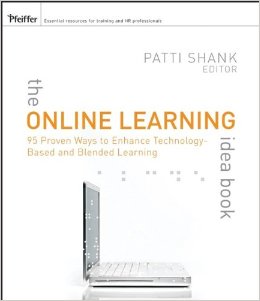Shank 2007
The Online Learning Idea Book
1. Références
- Référence complète APA : Shank, Patti (Ed.). (2007) The Online Learning Idea Book, Volume 2: 95 Proven Ways to Enhance Technology-Based and Blended Learning. San Francisco: Pfeiffer.
- Auteur(s) : Patti Shank
2. Copies
- Copie électronique en ligne :
- Copie électronique locale :
- Copie physique CP :
- Copie physique en bibliothèque : Bibliothèque PRAC-TICE
3. Mots-clés
4. Quart de couverture
5. Table des matières (facultatif)
- Introduction.
- SECTION 1. LEARNERS, ACTIVITIES, AND ASSESSMENTS.
- Chapter 1. Ideas for Supporting Learners and Learning.
- Learning Agreements.
- Prework Verification.
- Study Schedule.
- Performance Tips.
- Move It.
- Confirm Exercise Instructions.
- E-Portfolio.
- Anonymous Weekly Survey.
- Personal Wishes.
- Really Simple Syndication Feeds.
- Contingency Plans.
- Virtual Office Hours.
- Chatbots.
- Chapter 2. Ideas for Making Collaboration Work.
- Group Formation.
- Prep for Collaborative Work.
- Team Agreement Template.
- Team Assessment.
- Rules of Engagement Agreement.
- Team Review Form.
- Chapter 3. Ideas for Making Discussions Work.
- Discussion Message Protocols.
- Evaluate Your Contribution.
- Karma Points for Contributions.
- Acronym and Emoticon Help.
- Chapter 4. Ideas for Self-Directed and Asynchronous Activities.
- Table Organizers.
- Red Dog.
- Enter, Compare, Print, and Discuss.
- Tell Me Why.
- Time Me.
- Digital Stories.
- Share Bookmarks.
- Tell Me About Yourself.
- An Expert View.
- Email the Author.
- MiniQuest.
- Blog It.
- My Chair.
- Easy Peer Editing.
- Introducing Critical Evaluation.
- Chapter 5. Ideas for Synchronous Activities.
- Chat Moderator.
- Come (Back) Early.
- Low-Tech Listening Exercise.
- Trainer-Expert Collaboration.
- Pyramid.
- Before Ninety.
- Daring Feats.
- Spotlights.
- Vowels.
- Gordon Mackenzie-Style Lecture.
- Vanity License Plate.
- Lighten Up.
- Where Are You?
- Word Search.
- Chapter 6. Ideas for Self-Check Activities and Assessments.
- Adapted Classroom Assessment Techniques.
- Review Puzzles and Games.
- Flash Cards.
- Know Your Flooring.
- Board Game Self-Check.
- Drag-and-Drop Self-Check.
- Fact-or-Fiction Self-Check.
- Mixed Signals.
- Millionaire Game.
- Show Training Value.
- SECTION 2. INSTRUCTIONAL DESIGN.
- Chapter 7. Ideas for the Design and Development Process.
- Process Flowchart.
- Design Guidelines.
- Learner Stories.
- Personalized Learning Model.
- Content Templates.
- Fast E-Learning Templates.
- Chapter 8. Ideas for Navigation and Usability.
- Concept Maps and Causal Loops for Navigation.
- Collapsible and Movable Text Layer.
- Automated Back and Next Buttons and Page Numbering.
- Double Use Glossary.
- Automated Reference.
- Here’s What’s New.
- Chapter 9. Ideas for Creative Design.
- Funny Stats.
- Take the Metro.
- Metaphors to Aid Learning.
- Stories to Understand the Big Picture.
- Virtual Coach.
- Field Clinic.
- Outrageous Nonexamples.
- What I Really Think.
- Virtual Campus.
- Visual Ideas.
- Chapter 10. Ideas for Creative Media.
- Show Me.
- Slow or Fast Images.
- Energy Balance.
- Interactive History.
- Interactive Physics.
- Inside a Cell.
- Sea Vents.
- Tsunami.
- Movement Sensors.
- Genome Timeline.
- DNA Sliding Clamp.
- DNA Sequence Explorer.
- Build Your Own Instructional Game.
- It’s NOT Ninety-Five.
- Glossary.
6. Résumé personnel (facultatif)
7. Voir aussi
